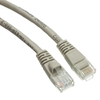Cat 5e vs. 6 vs. 6a: What you need to know
Created on: Apr 14, 2017
Cat5e vs Cat6 vs Cat6a

General
When purchasing network cables for a new business installation, data center expansion, or connecting end users, it's important that you choose the correct network cable. The choice between Cat5e, Cat6, and Cat6a can be difficult to make without knowing the differences between them.
Similarities between Cat5e, Cat6, and Cat6a
- All three types of ethernet cable are made using 4 pairs of twisted copper wire to transfer data.
- All three types use the same RJ45 connector on the end. This is important because it means these all fit into the same type of port on a computer, router, switch, game console, etc.
- All three cables are compatible with each other. When multiple different cables are used on a link, the cable with the slowest speed simply becomes a bottleneck.
- All three cables data transfer rates are affected by distance, the longer the cable distance the slower the speeds. This is one of the main reasons to choose one cable over another, the better the cable, the faster the speeds are at longer distances due to improvements in the number of twists and separation of pairs.
 Cat 5e Cat 5e |  Cat 6 Cat 6 |  Cat 6a Cat 6a |
Terms
Before we get too far, lets define some terms so we're all on the same page
Near End Cross talk (NEXT)
For the purpose of this article, NEXT can be defined as "interference between two pairs in a cable", this is measured at the same end of the cable as the 'interfering transmitter'. Basically, this means that when a signal is sent down a twisted pair, the electrical signal could "bleed" out of the intended twisted pairs into others. As the levels of NEXT increase, transmission errors occur showing up as Runts, CRC's, and framing errors. As an analogy, imagine two sets of people standing across from each other. Each person is trying to communicate with their parter directly across from them. However, because there are two people talking, you will hear noise from both of them, possibly causing confusion.
Cat5e
Cat5e (Enhanced Category 5) is in upgraded version of the Cat5 cable that was made to support 1000Mpbs Gigabit ethernet speeds. Cat5e allows you to get 1 Gbps speeds operating at a frequency of up to 100 MHz, due to reduction of crosstalk and other improvements over the Cat5 standard. Cat5e supports speeds of 10BASE-T, 100BASE-T, and 1000BASE-T, allowing it to be backward compatible with older IT equipment. Cat5e features the standard RJ45 connector on both sides of the cable, which is the standard connector used in almost all consumer IT products. The maximum length for Cat5e at 1 Gbps speeds is 100M. Cat5E does not have a separator between the twisted pairs, and this is the primary difference between Cat5e and Cat6.
Cat5e allows 1 Gbps (1000 Mpbs) speeds up to 100 meters
Reduces crosstalk over standard Cat5 cable.
Cat6
Cat6 (Category 6) cable is next step after Cat5e cable, and provides improvements in interference and crosstalk to support speeds up to 10 Gbps in lengths up to a max of 50M. Cat6 cables use the same RJ-45 connectors as Cat5e, making them fully compatible with older IT equipment and computers. Cat6 supports speeds up to 1Gps at a max bandwidth of 250MHz for lengths of up 100M and provides reduced interference and crosstalk over Cat5e, making speeds slightly faster over Cat5e.
Cat6 allows 10 Gbps (10000 Mpbs) speeds up to 50M
Reduces crosstalk and interference over Cat5e cable.
Cat6a
Cat6a (Augmented Category 6) cable is an upgraded version of Cat6 cable and is capable of supporting 10Gbps over 100M runs at a maximum bandwidth of 500MHz. Cat6a is noticeably thicker than Cat6 cable due to increased insulation in the cable to help reduce cross-talk between wires. This is one of the only drawbacks of using Cat6a cables as it require additional space in conduits, cable trays, and patch panels. Cat6a is backwards compatible with Cat6 and Cat5e cables, using the same RJ-45 connector. Cat6a is considered a future-proof cable install due to support of 10 Gbps speeds and is the standard cable installed for commercial network backbones for short pulls.
Cat6a allows 10 Gbps (10000 Mpbs) speeds up to 100M
Reduces crosstalk and interference over Cat6 cable.
Which cable should I use on my next install?
With the different options available today, it can be difficult to choose the correct cabling for your next install. Below, we review the common cable choices used in different applications.
Home/SoHo/Residential
In Home/SOHO installations, Cat5e is the most often used cable. The reason Cat5e is the most practical option used in home installations is due to cost and speed. Cat5e is the least expensive option of the ethernet cables listed, and with speeds up to 1Gbps, can handle pretty much anything a standard user can throw at it. Most ISP's (Internet Service Providers) provide between 10Mpbs and 100Mpbs speeds for home internet plans, meaning that internet speeds are limited by the ISP, not by the cabling in the home itself. Even in data transfer between devices on your network, such as copying videos between devices, streaming movies, moving files, etc, the limiting factor is generally the HDD/SSD read/write speed and the bandwidth of your network switch, not the speed of the cable. Typical use cases in a home scenario are to connect a router to a switch, or a switch to a computer. Cat6 may be recommended however, if you are installing permanent cabling in a new home installation with longer pulls, this will ensure the network fabric of your new home is future proofed to higher bandwidth usage.
Cat5e or Cat6 often used in home installations
Small Office
Small Office installations bring additional decisions to which cable to choose. Cat6 is now considered them minimum standard to use in most commercial installs due to the price being comparable to Cat5e and allowing higher performance over Cat5e cables. Cabling choice on new office installs is typically based off of the expected lifetime of the network. If the network is expected to be installed for > 10 years, Cat6a is recommended if the pull does not justify using fiber optics to future-proof the install as file sizes, internet usage, and video quality continues to increase.
Cat6 in new small commercial install
Large Commercial Applications
Cat6 is the standard for new enterprise and large commercial applications where fiber optic cable is not needed.
Data Centers
Data centers typically choose Cat6 or Cat6a to ensure networks are future proofed. Data centers typically choose Fiber Optic cables for any high bandwidth applications such as connecting aggregation switches and edge switches. Cat6 cables are frequently used to connect servers to edge TOR (top of rack) switches.
The Technical Stuff
Now that we have reviewed the general info on each cable, lets look at detailed technical information.
| Cat5e | Cat6 | Cat6a | |
|---|---|---|---|
Max Speeds | 1000 Mpbs (1 Gbps) | 10 Gbps between ~37M-50M 1Gbps up to 100M | 10 Gbps up to 100M |
Max Bandwidth (Frequency) | 100 MHz | 250 MHz | 500 MHz |
Supported IEEE Standards | 10BASE-T, 100BASE-T, 1000BASE-T | 10BASE-T, 100BASE-T, 1000BASE-T, 1000BASE-TX | 10BASE-T, 1000BASE-T, 10000BASE-T, 1000BASE-TX, 10GBASE |
Standard Gauges | 24 AWG | 23 AWG | 23 AWG |

Author:
Brian Sackett
Marketing & Development




